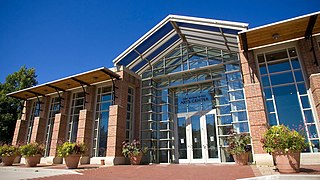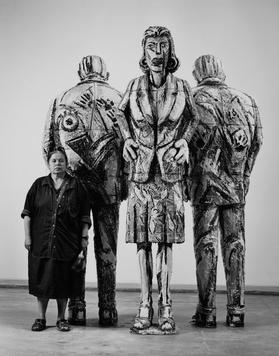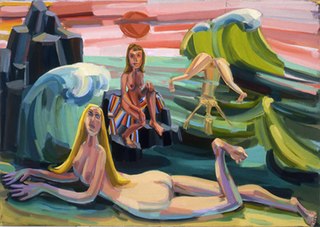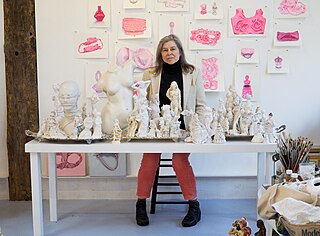Eugene Von Bruenchenhein (1910–1983) was an American self-taught artist from Milwaukee, Wisconsin. Over the course of fifty years, from the 1930s until his death in 1983, Von Bruenchenhein produced an expansive oeuvre of poetry, photography, painting, drawing and sculpture. His body of work includes over one thousand colorful, apocalyptic landscape paintings; hundreds of sculptures made from chicken bones, ceramic and cast cement; pin-up style photos of his wife, Marie; plus dozens of notebooks filled with poetic and scientific musings. Never confined to one particular method or medium, Von Bruenchenhein continually used everyday, discarded objects to visually explore imagined past and future realities.

Dorothea Rockburne, DFA is an abstract painter, drawing inspiration primarily from her deep interest in mathematics and astronomy. Her work is geometric and abstract, seemingly simple but very precise to reflect the mathematical concepts she strives to concretize. "I wanted very much to see the equations I was studying, so I started making them in my studio," she has said. "I was visually solving equations." Her attraction to Mannerism has also influenced her work.

The John Michael Kohler Arts Center is an independent, not-for-profit contemporary art museum and performing arts complex located in Sheboygan, Wisconsin, United States. The center preserves and exhibits artist-built environments and contemporary art. In 2021, the center opened the Art Preserve, a satellite museum space dedicated to art environments.

Karen Karnes was an American ceramist, best known for her salt glazed, earth-toned stoneware ceramics.
Walter Martin & Paloma Muñoz, also known as Martin & Muñoz are artists who collaborate to create dystopian sculptures and large photographic works often based on dioramas.

Helen Cordero was a Cochiti Pueblo potter from Cochiti, New Mexico. She was renowned for her storyteller pottery figurines, a motif she invented, based upon the traditional "singing mother" motif.
Martha Wilson is an American feminist performance artist and the founding director of Franklin Furnace Archive art organization. Over the past four decades she has developed and "created innovative photographic and video works that explore her female subjectivity through role-playing, costume transformation, and 'invasions' of other peoples personas". She is a recipient of two National Endowment for the Arts fellowships, a New York Foundation for the Arts fellowship, and an Obie Award and a Bessie Award for commitment to artists’ freedom of expression. She is represented by P•P•O•W gallery in New York City.

Viola Frey was an American artist working in sculpture, painting and drawing, and professor emerita at California College of the Arts. She lived and worked in the San Francisco Bay Area and was renowned for her larger-than-life, colorfully glazed clay sculptures of men and women, which expanded the traditional boundaries of ceramic sculpture.

Judith Linhares is an American painter, known for her vibrant, expressive figurative and narrative paintings. She came of age and gained recognition in the Bay Area culture of the 1960s and 1970s and has been based in New York City since 1980. Curator Marcia Tucker featured her in the influential New Museum show, "'Bad' Painting" (1978), and in the 1984 Venice Biennale show, "Paradise Lost/Paradise Regained: American Visions of the New Decade." Linhares synthesizes influences including Expressionism, Bay Area Figuration, Mexican modern art and second-wave feminism, in work that flirts with abstraction and balances visionary personal imagery, expressive intensity, and pictorial rigor. Art historian Whitney Chadwick wrote, "Linhares is an artist for whom painting has always mattered as the surest path of synthesizing experience and interior life," her works "emerging as if by magic from an alchemical stew of vivid complementary hues and muted tonalities." Critic John Yau describes her paintings "funny, strange, and disconcerting," while writer Susan Morgan called them "unexpected and indelible" images exploring "an oddly sublime territory where exuberant bliss remains inseparable from ominous danger."

Arlene Shechet is an American sculptor known for her inventive, gravity-defying arrangements and experimental use of diverse materials. Critics describe her work as both technical and intuitive, hybrid and polymorphous, freely mixing surfaces, finishes, styles and references to create visual paradoxes. Her abstract-figurative forms often function as metaphors for bodily experience and the human condition, touching upon imperfection and uncertainty with humor and pathos. New York Times critic Holland Cotter wrote that her career "has encompassed both more or less traditional ceramic pots and wildly experimental abstract forms: amoebalike, intestinal, spiky, sexual, historically referential and often displayed on fantastically inventive pedestals … this is some of the most imaginative American sculpture of the past 20 years."

Erin M. Riley is a Brooklyn-based artist whose work focuses on women and women's issues primarily in hand-woven hand dyed wool tapestries. Riley's work challenges society's comfort level by displaying shocking images including nudity, drugs, violence, self harm, sexuality, and menstruation.
Jack Earl is an American ceramic artist and former teacher, known for drawing inspiration from his home state of Ohio to create rural pieces “with meticulous craftsmanship and astute details… to where you could smell the air, hear the silence and swat the flies.” Although his works hint at highly personal, intellectual, and narrative themes in an almost unsettling manner, Earl is “a self-described anti-intellectual who shuns the art world." He is known particularly for using his trademark format, the dos-a-dos : “This art form is like a book with two stories… the two seemingly incongruent images prompt the viewer to fill in the conceptual gap through poetic speculation.” His work often involves dogs or the character “Bill”, who is said to be a combination of Earl’s father-in-law, himself, and others. The titles to his pieces are typically lengthy, stream-of-consciousness narratives that suggest the folk or rural lifestyle. These are intended to add another dimension to the artwork. His work has received a notable response over his decades-long career, especially since he is regarded as “a master at reminding us that within the events we take for granted are moments of never-ending mystery and wonder.” Earl continues to live in Lakeview, Ohio with his wife, Fairlie.

Portia Munson is an American visual artist who works in sculpture, installation, painting and digital photography, focusing on themes related to the environment and feminism. Her work includes large-scale agglomerations of mass-produced plastic found objects arranged by color, as well as small oil paintings of individual domestic found objects, and digital photographs of flowers, weeds and dead animals found near her home in upstate New York.
Cyrilla Mozenter is a New York-based artist known for her hand stitched industrial wool felt freestanding and wall pieces that include the transplantation of cutout letters, letter-derived, and pictogram-like shapes, as well as her hybrid works on paper, incorporating drawing, writing, painting, and collage. Her works make reference to the writings of Gertrude Stein. Awarded a Guggenheim Fellowship in 2020, her work is represented in many public collections including The Brooklyn Museum and The Yale University Art Gallery.

Beth Katleman is an American artist known for porcelain assemblage sculpture cast from found objects. Her allegorical installations fall within the genre of pop surrealism, combining decorative elements, such as Rococo embellishments and 19th century Toile de Jouy wallpaper scenery, with satirical references to consumer culture, fairy tales and classic literature. Katleman's work is in private and institutional collections and is exhibited internationally, including an installation commissioned by architect Peter Marino for Christian Dior, in the Hong Kong and London flagship boutiques. She lives and works in Brooklyn, New York, and is the recipient of the 2011 Moët Hennessey Prize, a Mid-Atlantic Arts Foundation grant, the Watershed Generation X Award, a Kohler Arts/Industry Fellowship and a residency in Cortona, Italy sponsored by the University of Georgia, Athens. Katleman holds a BA in English from Stanford University, an MFA from Cranbrook Academy of Art and an MBA in Arts Management from UCLA.

Nancy Selvin is an American sculptor, recognized for ceramic works and tableaux that explore the vessel form and balance an interplay of materials, minimal forms, and expressive processes. She emerged in the late 1960s among a "second generation" of Bay Area ceramic artists who followed the California Clay Movement and continued to challenge ceramic traditions involving expression, form and function, and an art-world that placed the medium outside its established hierarchy. Her work has been exhibited at the Los Angeles County Museum of Art (LACMA), Denver Art Museum, Daum Museum of Contemporary Art and Kohler Arts Center, and belongs to the public art collections of LACMA, the Smithsonian Institution, Oakland Museum of California, and Crocker Art Museum, among others. Critic David Roth has written, "Selvin's position in the top rank of ceramic artists has come through a process of rigorous self-examination … what differentiates [her] is that she eschews realism and functionality, indicating a level of intellectual engagement not always found among ceramicists." Writer and curator Jo Lauria described Selvin's tableaux as "elegiac and stylistically unified" works that serve as "forceful essays on the relationship between realism and abstraction, object and subject, decoration and use." Selvin lives and works in the Berkeley, California area.

Elana Herzog is an American installation artist and sculptor based in New York City. She is most known for abstract, tactile works in which she disassembles, reconfigures and embeds second-hand textiles in walls, modular panels and architectural spaces with industrial-grade metal staples. Herzog has been recognized with a Guggenheim Fellowship, Anonymous Was a Woman Award and Louis Comfort Tiffany Foundation Award, among others. She has exhibited nationally and internationally, including at the Brooklyn Museum, Museum of Arts and Design (MAD), Tang Museum, Weatherspoon Art Museum, Sharjah Art Museum, and Reykjavik Art Museum.
Allison Schulnik is an American painter, sculptor and animated filmmaker. She is known for her heavily textured, impasto oil paintings and her animated short videos. Schulnik is married to fellow artist Eric Yahnker. They live and work in Sky Valley, California.

Katharine Kuharic is an American artist known for multi-layered representational paintings that combine allegory, humor, social critique, and aspects of Pop and pastoral art. Her art typically employs painstaking brushwork, high-keyed, almost hallucinogenic color, discontinuities of scale, and compositions packed with a profusion of hyper-real detail, figures and associations. She has investigated themes including queer sexual and political identity, American excess and suburban culture, social mores, the body and death. Artist-critic David Humphrey called Kuharic "a visionary misuser" who reconfigures disparate elements into a "Queer Populist Hallucinatory Realism" of socially charged image-sentences that shake out ideologies from "the congealed facts of contemporary culture" and celebrate the possibility of an alternative order.
Jean Blackburn is an American artist and educator known for her paintings, sculptures, installation arts, and illustrations. She is also a professor in the Illustration department at Rhode Island School of Design, since 1982. She has lived in New York City, and Rhode Island.
















